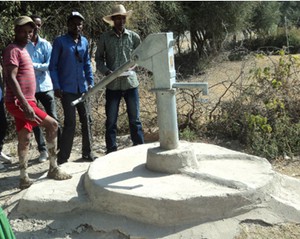Climate policies
As you know from previous study sessions, climate change is causing higher temperatures and changing rainfall patterns leading to increased drought and flooding. Flooding can destroy poorly constructed latrines and pumps and contaminate drinking water sources unless they are built with the risks from flooding in mind.
Look at the pump in Figure 15.4. What aspects of its construction will help resist damage from flooding?
The base is raised higher than the ground surface and it has a solid concrete cover which should be watertight to prevent floodwater entering the well or borehole.

Figure 15.4 A newly constructed hand pump.
Ethiopian Programme of Adaptation to Climate Change (EPACC)
On the basis of its vulnerability to climate change, Ethiopia adopted the National Adaptation Programme of Action in 2007. This was updated with the Ethiopian Programme of Adaptation to Climate Change in 2011, which looks at the challenges of climate change and seeks to design adaptation responses (The Red Desk, 2015).
EPACC envisages that each sector, region and local community in Ethiopia will have its own programme of adaptation. Adaptation practices are indicated for each sector including crop production, livestock, water, health, education, energy, infrastructure, institutional capacity and cultural heritage.
Climate Resilient Green Economy Strategy
While the EPACC focuses on climate change adaptation, the government’s Climate Resilient Green Economy (CRGE) strategy, also launched in 2011, focuses on climate change mitigation. It seeks to cut the country’s carbon emissions, as you read in Study Session 12.
What is the overall aim of the CRGE strategy?
It aims to limit greenhouse gas emissions to 2011 levels while supporting economic development and growth.